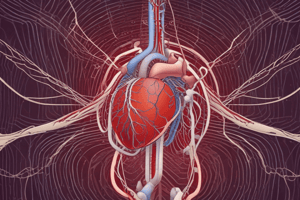Podcast
Questions and Answers
What role do the renal arteries play in the human circulatory system?
What role do the renal arteries play in the human circulatory system?
- Supply blood to the brain
- Deliver oxygenated blood to the kidneys (correct)
- Distribute blood to the arms and shoulders
- Carry deoxygenated blood to the lungs
Which layer of the artery wall is primarily responsible for elasticity and recoil?
Which layer of the artery wall is primarily responsible for elasticity and recoil?
- Tunica Intima
- Tunica Externa
- Tunica Media (correct)
- Endothelial layer
What characterizes elastic arteries compared to muscular arteries?
What characterizes elastic arteries compared to muscular arteries?
- Have fewer elastic fibers
- Are smaller in diameter
- Deliver blood to specific tissues
- Can expand and recoil with blood pressure changes (correct)
In systemic circulation, where does the aorta carry oxygenated blood?
In systemic circulation, where does the aorta carry oxygenated blood?
What is the primary function of arterioles in the circulatory system?
What is the primary function of arterioles in the circulatory system?
How does blood pressure change as blood moves from arteries to capillaries?
How does blood pressure change as blood moves from arteries to capillaries?
Which artery is responsible for supplying blood to the head and neck?
Which artery is responsible for supplying blood to the head and neck?
What are pulmonary arteries classified as, despite their unique function?
What are pulmonary arteries classified as, despite their unique function?
What structural feature of arteries helps them withstand high blood pressure?
What structural feature of arteries helps them withstand high blood pressure?
In arterial circulation, what primarily drives the flow of blood through the arteries?
In arterial circulation, what primarily drives the flow of blood through the arteries?
Flashcards
Artery function
Artery function
Carry oxygenated blood away from the heart to the body.
Aorta
Aorta
Largest artery, carries blood from the heart to the body.
Systemic circulation
Systemic circulation
Blood flow from the heart to body and back.
Arterioles
Arterioles
Signup and view all the flashcards
Capillaries
Capillaries
Signup and view all the flashcards
Tunica Intima
Tunica Intima
Signup and view all the flashcards
Tunica Media
Tunica Media
Signup and view all the flashcards
Tunica Externa
Tunica Externa
Signup and view all the flashcards
Blood pressure
Blood pressure
Signup and view all the flashcards
Elastic Arteries
Elastic Arteries
Signup and view all the flashcards
Study Notes
Arteries of the Human Body
- Arteries are blood vessels that carry oxygenated blood away from the heart to the rest of the body. They are vital for delivering nutrients and oxygen to tissues and removing waste products.
- They have a thick, elastic layer of smooth muscle in their walls to withstand the high pressure of blood ejected from the heart.
Functions of Major Arteries
- The aorta is the largest artery and carries oxygenated blood from the left ventricle of the heart to all parts of the body. Smaller branches from the aorta supply oxygenated blood to the brain, kidneys, and other organs.
- Major arteries like the common carotid arteries distribute blood to the head and neck.
- The subclavian arteries supply blood to the arms and shoulders.
- The renal arteries supply blood to the kidneys.
- The iliac arteries deliver blood to the lower extremities.
- Pulmonary arteries, while technically arteries, carry deoxygenated blood from the heart to the lungs for oxygenation.
Arterial Circulation
- Systemic circulation refers to the flow of blood from the heart to the body and back to the heart. Arterial circulation is a key component of this system.
- Blood pressure, which is generated by the pumping action of the heart, is essential for driving blood through the arteries.
- Arterioles are smaller branches of arteries that regulate blood flow to specific tissues, adjusting in response to local metabolic needs.
- Capillaries are microscopic blood vessels connecting arterioles to venules, enabling the exchange of nutrients and waste products between blood and tissues. Blood pressure decreases significantly as it moves from arteries through arterioles to capillaries.
Structure of Arteries
- The walls of arteries consist of three distinct layers:
- Tunica Intima: The innermost layer, composed of endothelial cells and a thin basement membrane.
- Tunica Media: The middle layer, primarily made up of smooth muscle and elastic fibers. The thickness of this layer varies depending on the size of the artery, with larger arteries having more elastic fibers for elasticity and recoil.
- Tunica Externa (Adventitia): The outermost layer, composed of connective tissue that provides structural support.
Types of Arteries
- Elastic arteries (e.g., aorta, pulmonary trunk) have a high proportion of elastic fibers in their tunica media, allowing them to expand and recoil with each heartbeat, smoothing out pressure fluctuations.
- Muscular arteries (e.g., brachial, femoral arteries) exhibit a thicker tunica media composed primarily of smooth muscle, enabling them to regulate blood flow to specific organs and tissues.
- Arterioles are the smallest arteries, with a thin tunica media primarily composed of smooth muscle, enabling them to regulate resistance and blood flow to individual capillary beds.
Studying That Suits You
Use AI to generate personalized quizzes and flashcards to suit your learning preferences.




